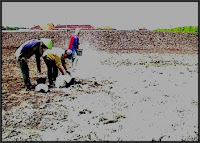loading...
LIME AS A SOIL AMENDMENT
This time, Ahli artikel will discuss an article about Lime as a Soil Amendment. Happy reading. . .
Lime as a Soil Amandement
About 23 million tons of limestone or equivalent lime materials are applied annually in the United States. Lime usually is regarded as a soil amendment rather than a fertilizer, although calcium, the essential ingredient in lime, may be deficient in some cases. The principal effect of liming in some cowpea-wheat experiments was to increase the amount of soil nitrogen available for crop use. Soil acidity can be corrected by applications of lime. Soils low in lime are frequently acid, a condition that occurs in humid regions where calcium is leached from the soil or removed by plants. Porous sandy soils leach readily and are more likely to be acid than are heavy soils under the same conditions. In South Carolina, approximately 40 per cent of the soils are strongly to extremely acid. This acidity is too high for satisfactory growth of even the somewhat acid-tolerant crops, tobacco and cotton, without liming.
Forms of Agricultural Lime
The chief forms of agricultural lime are crushed limestone, burned lime, and hydrated lime. Most lime originally comes from limestone rock where it occurs as calcium carbonate, the active element being calcium. Dolomitic limestone contains considerable quantities of magnesium carbonate. The value of crushed limestone depends upon the purity as well as the degree of fineness of the crushed particles. Limestone becomes more effective as the rock is ground finer. A common recommendation is for the material to be sufficiently fine for all of it to pass through a 10-mesh sieve and for 40 per cent of it to pass through a 100-mesh sieve.
The chief forms of agricultural lime are crushed limestone, burned lime, and hydrated lime. Most lime originally comes from limestone rock where it occurs as calcium carbonate, the active element being calcium. Dolomitic limestone contains considerable quantities of magnesium carbonate. The value of crushed limestone depends upon the purity as well as the degree of fineness of the crushed particles. Limestone becomes more effective as the rock is ground finer. A common recommendation is for the material to be sufficiently fine for all of it to pass through a 10-mesh sieve and for 40 per cent of it to pass through a 100-mesh sieve.
Burned lime or quicklime is prepared by burning limestone. Hydrated lime is formed when water is added to burning lime. Since limestone is only slightly soluble, it reacts slowly over a long period. Because of its lower cost, however, it is the form used for field application in acid soil regions, except where marl or oyster shells are available locally. The relative neutralization values of liming meterials, assuming pure calcium carbonate to be 100 per cent, are high calcium limestone, dolomite limestone, marl, oyster shells, hydrated lime, burned lime, and magnesium carbonate.
That is some explanation of articles on Lime as a Soil Amendment, hopefully we can add to the knowledge of the reader
That is some explanation of articles on Lime as a Soil Amendment, hopefully we can add to the knowledge of the reader
HAPPY LEARNING
SOURCE:
Book Principles of Field Crop Production | John H. Martin - Warren H. Leonard | COLLIER Macmillan (1967)
 | |
| Picture of Lime As A Soil Amendment |
loading...